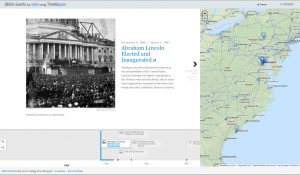Your final project for this course focuses on a consideration of the digital methods we have learned over the course of the semester, as demonstrated through expanded analysis of the archival collection of Linn’s diary that we have relied upon:
- a sound research question that offers a significant and original perspective on the subject matter with which we have engaged throughout the semester
- for single student a demonstrated competence in one; or
- for a collaborative project (between two students) demonstrated competence in least two of the digital methodologies
- screenshots that demonstrate process, experimentation, mastery, complications, difficulties and challenges, how these were met – and hopefully overcome)
- explanation about why particular method or tool was chosen
- determination of method/tool’s effectiveness in addressing research question
The project will consist of:
- a 150-200 word abstract (due Monday, 12/1 by 11pm in Word document via email) that identifies your research question and identifies the digital method you have chosen to address the question
- Short (3-5 minute) Powerpoint or Prezi presentation of final project in progress (in-class on December 8) that is an articulation of your research question, the reason why you have chosen your particular digital method, whether or not you believe it is helping you to answer to research question, and a demonstration of how you are building your argument through the tool/approach. ** This presentation is meant to show your work in progress rather than the finished, polished artifact, which comes next.
- Artifact (due December 17 linked from reflection essay in WordPress) that is one of the following: a published map, network visualization file structure, or uploaded TEI file(s). A submitted artifact includes all necessary files and folders made available to instructor via browser interface.
- GIS: ArcGIS Online story map
- Gephi: exported sigma .js folder uploaded to netspace
- TEI: content file(s) uploaded to TEI Boilerplate folder in netspace
- Voyant or TimeMapper visualization (Voyant or TimeMapper can only be used as secondary / complementary methodology when submitted by a collaborating team, and must demonstrate a distinctly enhanced point of view about the research question)
- An 850-1000 word reflection essay (due December 17 in WordPress) that includes a clear statement of your research question and methodology; and documentation of the process that leads to the completion of your project. Take screenshots of each significant phase of your project’s development (at least 5 screenshots from design to completion). Plus bibliography/webography, works cited, posted under the category “Final Project” and including five tags.
This project is worth 35% of your course grade. You will be graded according to the following guidelines:
- Rhetorical Awareness (25%): Argument considers audience, message, and medium (artifact and essay): since this is meant to be public-facing scholarship, think about who might be looking at your artifact (not only your instructor and classmates, but also the wider campus population and/or conference attendees if you should choose to submit your project to a research conference)
- Stance and Support (20%): Central claim is duly supported by evidence drawn from the core text, from readings, and from sample projects; i.e. evidence of original or expanded research into your subject matter
- Organization (15%): Clear structure demonstrates presentation of research question, critical analysis through method, and moves logically from introduction to conclusion
- Conventions (20%): Competent adherence to usage standards; skillful integration of core text and secondary sources – including citation
- Design for Medium (20%): Well-chosen design features enhance audience motivation and participation
Final project submission is on Final exam date December 17, as published here: http://www.bucknell.edu/FinalExamSchedule
